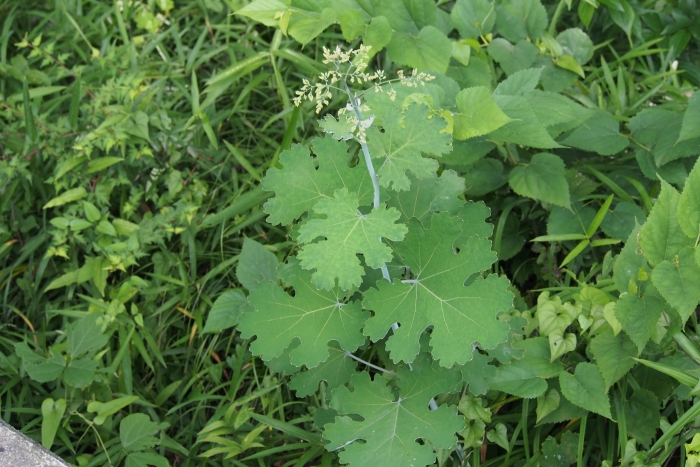Five-Seeded Plume-Poppy
(Macleaya cordata)
Five-Seeded Plume-Poppy (Macleaya cordata)
/
/

harum.koh
CC BY-SA 4.0
Image By:
harum.koh
Recorded By:
Copyright:
CC BY-SA 4.0
Copyright Notice:
Photo by: harum.koh | License Type: CC BY-SA 4.0 | License URL: http://creativecommons.org/licenses/by-sa/4.0/ | Rights Holder: harum.koh | Publisher: iNaturalist | Date Created: 2016-06-25T15:23:52-07:00 |































Estimated Native Range
Summary
Macleaya cordata, commonly known as Five-Seeded Plume-Poppy, is a deciduous perennial herb native to China, Taiwan, and Japan, where it is typically found along riverbanks, edges of ponds, and on slopes in open woodlands. It can grow up to 2.5 meters (8 feet) tall and 1 meter (3 feet) or more in width. The plant has distinctive olive green, lobed leaves and produces airy panicles of buff-white flowers during the summer, which are quite showy and attract pollinators. After flowering, it forms unique plume-like seed pods. The flowers come in shades of cream, pink, and white, adding a light, feathery texture to the garden landscape.
Five-Seeded Plume-Poppy is valued for its architectural form and the vertical interest it adds to borders and wild garden settings. It is also a popular choice for flower arranging due to its unique flower panicles. This plant has earned the Royal Horticultural Society’s Award of Garden Merit, indicating its excellence for garden use. While it is relatively easy to maintain, it requires space to accommodate its spreading habit. It self-seeds readily, which can lead to invasiveness if not managed. Gardeners should be aware of its potential to spread and plant it where it can be contained or in areas where its naturalization is desired. It thrives in full sun to part shade and is adaptable to a range of soil types, provided they have good drainage. Regular watering will keep it looking its best, but it can tolerate some drought once established.CC BY-SA 4.0
Five-Seeded Plume-Poppy is valued for its architectural form and the vertical interest it adds to borders and wild garden settings. It is also a popular choice for flower arranging due to its unique flower panicles. This plant has earned the Royal Horticultural Society’s Award of Garden Merit, indicating its excellence for garden use. While it is relatively easy to maintain, it requires space to accommodate its spreading habit. It self-seeds readily, which can lead to invasiveness if not managed. Gardeners should be aware of its potential to spread and plant it where it can be contained or in areas where its naturalization is desired. It thrives in full sun to part shade and is adaptable to a range of soil types, provided they have good drainage. Regular watering will keep it looking its best, but it can tolerate some drought once established.CC BY-SA 4.0
Plant Description
- Plant Type: Herb
- Height: 5-8 feet
- Width: 2-4 feet
- Growth Rate: Rapid
- Flower Color: White
- Flowering Season: Summer
- Leaf Retention: Deciduous
Growth Requirements
- Sun: Full Sun, Part Shade
- Water: Medium
- Drainage: Slow, Medium, Fast
Common Uses
Bee Garden, Deer Resistant, Drought Tolerant, Low Maintenance
Natural Habitat
native to China, Taiwan, and Japan, where it is typically found along riverbanks, edges of ponds, and on slopes in open woodlands
Other Names
Common Names: Plume-Poppy, Plume Poppy, Tree Celandine, Five-Seed Plume-Poppy, Weißer Federmohn, Vippvallmo, Storfruktig Vippvallmo, 博落迴, Jukjacho
Scientific Names: , Macleaya cordata, Bocconia cordata, Macleaya cordata f. glabra, Macleaya cordata var. thunbergii, Macleaya cordata var. yedoensis, Bocconia japonica, Bocconia jedoensis, Macleaya cordata subsp. thunbergii, Bocconia cordata subsp. thunbergii
GBIF Accepted Name: Macleaya cordata (Willd.) R.Br.